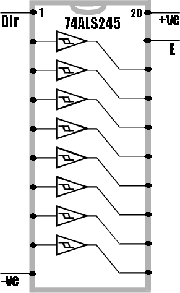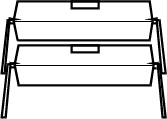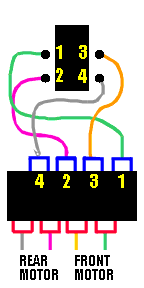|
|
|
This section covers connecting the Nv net to the Muscles,in this case that means motors. What follows is a Low Current solution.High current motors and drives present a whole new set of problems that,trustme, you don't wanna deal with right now. Besides, the MicroCore does it'sbest when driving through a Low gain system.
| 1: Rethinking the Nv net: By now you should have familurized yourself with the basic 6 Nv MicroCorecirciut. But a little math and you'll notice that with two motors and twodirections each 4 Nv's would seem apropriate.For basic walking funtiononly 4 of the 6 avialable Nv's are needed in a two motor walker (although6 makes for a whole new set of behavours), so rebuild the basic circiutso you get this....
Have no fear the other two Nv's will be useful later... |
2: The ALS245 Driver: The 74ALS245 is an Octal bus tranciever designed for data transmision.Well, "screw em" we are gonna use it to drive Motors. If you'vechosen you Motor/Gear combination properly then this won't be a problem.If you dig Up a TTL data book you'll see that the 245 has 8 bidirectionalnoninverting amplifiers each capable of driving 50mA, a direction pin (Dir)for selecting which way through the chip and an enable pin (E). If you tie the Dir pin to +ve and theE pin to -ve you can essentially think ofthe chip as 8 active drivers going from left to right like this graphic.... A data book will show you more but for the puposes of driving yourlegs this'll do...... The ALS version has been found to be the best for current, feedbacketc... CMOS such as HCT, HC, C will work but they loose a little in thefeedback. They do consume less parisitic power so for solar apps they arethe better choice..... If you are building a battery walker use ALS were ever you can andContrary to what some people will tell you you can still get them.... tryDIGI-KEY |
3: Ganging up for Current   |
4: The connection  |
| 5: Power Up |
| 6: |